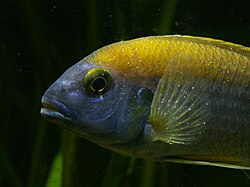Ichthyophthirius multifiliis
| Ichthyophthirius multifiliis | |
|---|---|
 |
|
| Cichlid showing the white spots characteristic of ich | |
| Scientific classification | |
| Domain: | Eukaryota |
| (unranked): | SAR |
| (unranked): | Alveolata |
| Phylum: | Ciliophora |
| Class: | Oligohymenophorea |
| Order: | Hymenostomatida |
| Family: | Ichthyophthiriidae |
| Genus: | Ichthyophthirius |
| Species: | I. multifiliis |
| Binomial name | |
|
Ichthyophthirius multifiliis Fouquet, 1876 |
|
Ichthyophthirius multifiliis (commonly known as freshwater white spot disease, freshwater ich, or freshwater ick) is a common disease of freshwater fish. It is caused by the protozoan Ichthyopthirius. Ich is one of the most common and persistent diseases in fish. The protozoan is an ectoparasite. White nodules that look like white grains of salt or sugar of up to 1 mm appear on the body, fins and gills. Each white spot is an encysted parasite. It is easily introduced into a fish pond or home aquarium by new fish or equipment which has been moved from one fish-holding unit to another. When the organism gets into a large fish culture facility, it is difficult to control due to its fast reproductive cycle and its unique life stages. If not controlled, there is a 100% mortality rate of fish. With careful treatment, the disease can be controlled but the cost is high in terms of lost fish, labor, and cost of chemicals.
Whitespot is very damaging to the gills and skin. In heavily infected fish it can cause a rapid deterioration of condition, considerable distress and death. Infected fish have small white spots on the skin and gills (Fig. 2 and Fig. 3) and produce excess mucus, due to irritation. Whitespot causes most damage when entering and leaving the tissues of the fish. This can lead to the loss of skin and ulcers. These wounds can harm the ability of a fish to control the movement of water into its body. Damage caused to the gill tissue of an infected fish can also reduce respiratory efficiency. This means it is more difficult for the fish to obtain oxygen from the water, and becomes less tolerant to low levels of dissolved oxygen.
The ich protozoan goes through these life stages:
This life cycle is highly dependent on water temperature, and the entire life cycle takes from approximately 7 days at 25 °C (77 °F) to 8 weeks at 6 °C (43 °F).
Marine ich is a similar disease caused by a different ciliate, .
There is no dormant stage in the lifecycle. However, any factor that reduces immunity, such as changes in water temperature and quality, accelerate an outbreak of Ich in a subclinically infected fish. Ammonia, nitrite or high levels of nitrate in water do not in themselves cause clinical cases of Ich. However, poor water quality stresses fish, which allows an outbreak to spread rapidly and increases mortality rates.
Other abiotic factors can increase both fish and tadpole susceptibility to ich. These factors include decreased temperature, predatory cues (crowding, fighting) and increased levels of UV-B radiation.
...
Wikipedia
